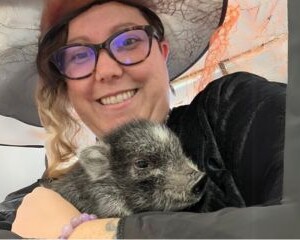From Wildlife Conservation to Veterinary Education: Emma Kaiser’s Journey of Passion and Knowledge
Emma Kaiser, DVM teaches Veterinary Technology students at Carrington’s Stockton campus in California. She has developed a wealth of knowledge in zoo and exotic animal medicine due to her diverse range of experiences treating domestic and exotic species in Africa, Europe, and the United States. Her impressive journey treating animals started with an ambitious early passion for wildlife conservation that sticks with her today. She is excited for today’s veterinary technology students to learn about the multitude of opportunities that exist for them in veterinary medicine.
 Please tell us about yourself.
Please tell us about yourself.
I grew up in Michigan and always knew that I wanted to work with animals. My passion from the time I was a little kid was wildlife conservation. I was saving frogs and snakes and all kinds of creatures from the backyard. Then, when I went to college at the University of Michigan for my undergraduate degree, I majored in biology because I love science. I planned to get a master’s degree in wildlife biology or ecology and enter the wildlife world. But then I ended up getting a job at a veterinary clinic near where I was living. It was there that I just kind of fell in love with the medical aspect of working with animals. My thoughts then changed to how I could combine veterinary medicine with my love of wildlife. My goal then became to go to veterinary school to become a wildlife veterinarian. I spent a lot of time volunteering at wildlife rehabilitation centers and zoos between getting my undergraduate degree and when I applied for veterinary school. This included spending six months in Sweden at an endangered species conservation facility.
Where did you go to veterinary school?
I went to Colorado State University. I spent all of my extra time there working with wildlife, volunteering, and dedicating my externship time to different wildlife agencies.
What did you focus on after graduating from Colorado State University?
After I graduated and became a veterinarian, I decided to enter the small animal veterinary world for a variety of reasons. A key reason was I wanted to gain experience doing things like surgery and practicing medicine on a large volume of animals. When you’re first starting you want to get as much experience as you can in basic medicine and surgery. Then you can apply it to other species if that is what you want to do.
 How long did you practice small animal medicine?
How long did you practice small animal medicine?
I practiced it for about five years. I also worked part-time at wildlife rehabilitation centers and volunteered at a zoo. Then, after about five years, I felt comfortable making the transition to one hundred percent zoo and wildlife, which was my dream. Then, when I was working at a zoo in Massachusetts, I had an opportunity to work about three days a week teaching pre-veterinary students at the University of Rhode Island. I had tutored in the past but had never taught a formal course. I still agreed to try teaching and ended up loving it. I stayed there teaching pre-veterinary courses to undergraduate students for a couple of years. That was when I fell in love with passing on knowledge and getting students excited about all the different things that you can do in veterinary medicine.
Where did you go after teaching at the University of Rhode Island?
For a while, I had wanted to spend time working for a nonprofit wildlife organization in a location that did not have many veterinary resources. I moved to Cameroon on the west coast of Africa to work at a wildlife sanctuary. I took care of animals that had been injured or orphaned by the bushmeat trade. That is the poaching trade. It was a life-changing experience and it opened my eyes to the unfortunate reality that so many of our planet’s animals face. After being in Cameroon for about a year, I was offered an opportunity to work at the Honolulu Zoo as a veterinarian, which I accepted.
When did you make the big move from Cameroon to Hawaii?
I moved in 2015 and it was a big move! I stayed on as a veterinarian at the Honolulu Zoo until last June, so for about seven years, and I was grateful for the opportunity. I became the head veterinarian for the last four years of my employment and felt very fortunate. I was able to do some teaching through the zoo. I also participated in conservation programs for wildlife, which was an amazing experience. Then, due to wanting to be closer to family and financial reasons–it is extremely expensive in Hawaii–my husband and I moved to California last June. That was right before I started at Carrington. Here in northern California, I have been able to combine my love of teaching at Carrington College with working a few days per week at a wildlife sanctuary.
What do you enjoy most about your work at Carrington?
I really enjoy it when students have ‘aha moments’ and understand how everything fits together. This often happens when something we have been teaching them at school applies to an animal they see during hands-on animal labs. I also enjoy introducing them to different areas within veterinary medicine because I feel like most people going into the field aren’t aware of the many opportunities that exist for them. There are opportunities with the USDA, at research laboratories, and at animal shelters.. Pharmaceutical companies also hire people within veterinary medicine all the time. Then there are zoos and wildlife sanctuaries. I enjoy introducing a variety of possibilities to the students.
Did you become a veterinary tech like your students before becoming a veterinarian?
Yes. However, back in those days–and it also depends on the state–licensing requirements for veterinary technicians varied between states. I was able to become a veterinary technician by gaining experience and showing proficiency in technical skills, rather than obtaining a license. Things have changed a lot in the field for the better, including making the profession adhere to standards of care via licensure.
Are there opportunities for veterinary technicians to work in wildlife sanctuaries and zoos?
Most wildlife sanctuaries and the majority of zoos hire veterinary technicians. They’re the backbone. They help with anesthesia, prepare medications, monitor the supplementation of animals, and keep track of when an animal is due for a vaccine. They also check feces for things like parasites and run blood analyses on the animals. Some small zoos will only have technicians on staff, and then a veterinarian will be on-site once or twice a week. That means the techs are really important.
When you were a student, were you interested in teaching?
That’s a good question. I always tutored, so I guess I was, but I don’t think I ever consciously thought, ‘Hey, I’m going to become a teacher someday.’
How would you say your experiences in the field have informed your teaching?
As I worked in wildlife medicine, especially with students and other volunteers that were still learning, I learned that teaching the foundation is the most important thing. This means a cat is a cat, whether you’re talking about a domestic cat or you’re talking about a Siberian tiger. Their anatomy and physiology are the same. The most important thing is to get the basic tenants of medicine, anatomy, and physiology down pat for basic mammal species. Then, if you have your knowledge base down, you can expand that learning to birds and reptiles and beyond.
I have also learned to let students try their practical skills at the beginning while also being okay with them not doing very well. The idea is that it’s going to take quite a bit of practice before they feel confident and are fully competent in a new skill. I need to emphasize to them that learning is a process.
Would you say that you have learned from your students?
Oh yes, I’ve learned from them. They’re constantly teaching me.
Do you have a favorite subject that you teach?
I am teaching the fifth-term students, which is a review of everything they’ve learned in preparation for their licensing exam. We cover every single subject in just a short review format each week. My favorite subjects are avian medicine and reptile medicine. I like pain management and anesthesia a lot as well.
What do you think Carrington provides veterinary tech students that they might not find elsewhere?
The program provides a lot of hands-on learning with real-life animals. That starts from the very beginning, during the first term. I think that is unique compared to other programs. Students learn how to properly restrain dogs and cats right away. They also start with syringe handling right away, which is an essential skill to perfect before you attempt to draw blood from an animal. It is important to be able to maneuver a syringe as if it’s part of your hand. Doing those things from the very beginning is a great thing and unique.
Does your program provide support and encouragement for students who might need accommodations or assistance?
Absolutely. I have been pleasantly surprised at how involved the instructors are with student success. If a student is absent from a class, instructors call to ask if they are okay. If a student doesn’t do well on an exam, instructors are immediately pulling that student aside and setting up tutoring if that’s what they need. There is also a company that Carrington works with that provides students with everything from emotional counseling to help with time management. They’ll also help with things like financial planning or family strife if someone has that going on in their life. I was impressed when I learned about all of the support they provide.
Do you have any advice for people interested in going into veterinary technology?
If you’re interested in the career, spend at least a few days volunteering at a veterinary clinic, shelter, or animal facility. That will give you a better idea of what your role would be within veterinary medicine and if that is what you want to do for a living. One thing that I have noticed is a lot of people like the idea of playing with puppies and kittens, but they aren’t necessarily interested in the intense science aspect of the field. They also aren’t ready for the emotional aspect of the job, which can be challenging. My advice would be to make sure you know what a vet tech does before starting a program.
Have we missed anything that you would like to include about yourself?
I’m married to a fellow animal lover and we have a cat that we adore named Popoki, which means cat in the Hawaiian language. I also love to do anything outdoors that is active like hiking, backpacking, camping, and bicycling. Oh, and curling up with a good book is one of my favorite quiet activities.


